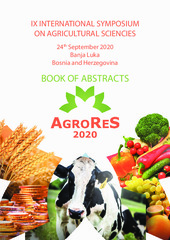Приказ основних података о документу
Migratory behaviour of Parthenolecanium corni Bouché (Hemiptera: Coccidae) developmental stages on grapevine
| dc.creator | Simonović, Marija Z. | |
| dc.creator | Graora, Draga Đ. | |
| dc.date.accessioned | 2024-01-18T07:57:15Z | |
| dc.date.available | 2024-01-18T07:57:15Z | |
| dc.date.issued | 2020 | |
| dc.identifier.isbn | 978-99938-93-63-9 | |
| dc.identifier.uri | http://aspace.agrif.bg.ac.rs/handle/123456789/6802 | |
| dc.description.abstract | Parthenolecanium corni Bouché (Hemiptera: Coccidae) is an important grapevine pest in many vine-production regions in Europe. The aim of this research was to determine migratory behavior of mobile developmental stages as well as preferred parts of grapevine for larvae and adults settlement. The research was conducted from September 2018 to December 2019 in Neštin area (Serbia). Samples were collected according to Hoffmann (2002). Grapevine phenological growth stages were determined by BBCH scale identification key according to Lorenz et al. (1994). During this research, we have recorded that different P. corni developmental stages change their position on the grapevine throughout the year. It has one generation per year and overwinters as second instar larva under the bark of the trunk. At the end of bud swelling (BBCH-3), overwintering larvae moved from trunk to cordon. First females were formed when inflorescences were swelling with flowers closely pressed together (BBCH-55) and 90% of female population was located on the cordon while only 10% of them was on the trunk of grapevine. On first third of the cordon, nearest to the trunk, 65% of females were settled, 26% on the second and only 1,46% on the last third. Oviposition took place when inflorescences were fully developed with separated flowers (BBCH-57). First instar larvae appeared when young fruits began to swell (BBCH-71) and they migrated to the leaves. About 43% of first instar larvae population was settled on the leaves nearest to the trunk and cordon. During the summer they were feeding on the leaves and in September (BBCH-91) they moulted into second instar larvae. At the beginning of leaf-fall (BBCH-93), second instar larvae started migration to the trunk, under the bark, to overwinter. Data about P. corni migration behavior on grapevine may be used for proper monitoring and determination of appropriate control measures. | sr |
| dc.language.iso | en | sr |
| dc.publisher | University of Banja Luka Faculty of Agriculture | sr |
| dc.relation | info:eu-repo/grantAgreement/MESTD/MPN2006-2010/146008/RS// | sr |
| dc.rights | openAccess | sr |
| dc.rights.uri | https://creativecommons.org/licenses/by/4.0/ | |
| dc.subject | Coccidae | sr |
| dc.subject | grapevine | sr |
| dc.subject | migratory behaviour | sr |
| dc.title | Migratory behaviour of Parthenolecanium corni Bouché (Hemiptera: Coccidae) developmental stages on grapevine | sr |
| dc.type | conferenceObject | sr |
| dc.rights.license | BY | sr |
| dc.citation.epage | 71 | |
| dc.citation.spage | 70 | |
| dc.identifier.fulltext | http://aspace.agrif.bg.ac.rs/bitstream/id/25987/bitstream_25987.pdf | |
| dc.identifier.rcub | https://hdl.handle.net/21.15107/rcub_agrospace_6802 | |
| dc.type.version | publishedVersion | sr |


